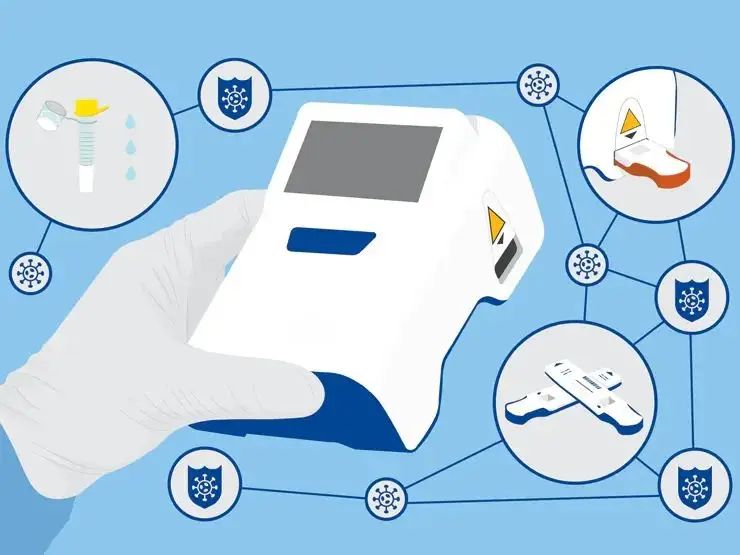What is molecular instantaneous testing (POCT) technology?
Molecular POCT technology integrates molecular diagnostic technology and POCT technology, with the advantages of intelligence, portability, speed, easy operation, can be operated by non-professionals in the laboratory and outside the hospital to complete the test, due to the continuous development and maturation of isothermal amplification and microfluidic technology, molecular POCT products have also been developed rapidly and gradually The molecular POCT products have also been rapidly developed and gradually applied to clinical testing. Translated with DeepL.com (free version)
Currently molecular POCT can be applied not only in the testing of infectious diseases, but also used in the diagnosis of early pregnancy, hereditary diseases, tumors and so on.
Compared with antigen-antibody tests, POCT tests for nucleic acid molecules offer significant advantages in terms of sensitivity, reproducibility and specificity.
The key technologies of molecular POCT include isothermal amplification technology and microfluidic technology, which are mainly introduced in this paper.

isothermal amplification technology
Isothermal amplification technology is a new type of nucleic acid amplification technology based on constant temperature amplification developed in recent years, which mainly includes loop-mediated isothermal amplification (LAMP), recombinase polymerase amplification (RPA), cross-primer amplification (CPA) and so on, of which LAMP and RPA are widely used in the field of nucleic acid testing of pathogenic microorganisms, such as the new coronavirus.
Loop-mediated isothermal amplification
LAMP is a technique for rapid amplification of DNA molecules under isothermal conditions of 60°C to 65°C.
The principle is that DNA is in dynamic equilibrium at about 60℃~65℃, and the strand replacement and cyclic replication are continuously carried out by four specific primers and thermophilic Bacillus subtilis DNA polymerase (BstDNA polymerase).
The reaction steps mainly include:
1) The internal primer binds to the target gene, which is extended into a double strand by the action of BstDNA polymerase. The external primer binds to the 5' end of the double-stranded DNA, forming a ring-like structure at one end, and the other end undergoes the same process to form a dumbbell-like structure with rings at both ends;
2) Single-stranded DNA with a dumbbell-like structure serves the dual function of template and primer, and can be extended when catalyzed by BstDNA polymerase;
3) The internal primer also binds to the ring structure and extends in the presence of the enzyme.
LAMP has the advantages of high amplification efficiency and short reaction time, and its amplification products can be used to quickly determine the results by electrochemical sensors, lateral flow test strips and other methods, and the operation is relatively simple.
However, the primer design of this technique is cumbersome, the sensitivity is relatively low, and it is easy to form aerosols, leading to false-positive results, and the accuracy and sensitivity are significantly lower than that of the fluorescent quantitative PCR technique.

Recombinase polymerase technology
RPA utilizes the principle of homologous recombination for the amplification of the target fragment. Under the condition of 37℃~42℃, the recombinase protein binds to the oligonucleotide primer to form the primer recombinase complex, which binds to the double-stranded DNA template after it finds the target point, and the DNA double-strand is replaced to form the D-loop structure, and DNA replication and extension is carried out under the catalytic action of DNA polymerase.
During this time, single-stranded binding proteins bind to free single-stranded DNA, preventing it from pairing with the parent strand.
RPA performs nucleic acid amplification under isothermal conditions and has the advantages of high specificity, short amplification time and easy operation.
However, this technology has high primer requirements, and there are no software tools for primer and probe design specifically for RPA; in addition, it is not possible to use this technology to test short-sequence nucleic acids, and the cost of testing is high.
Microfluidics-based POCT chips
With the continuous development of microfluidic chip technology and isothermal amplification technology, the types of matching microfluidic chip types are constantly enriched, such as centrifugal isothermal amplification microfluidic chip, integrated isothermal amplification microfluidic chip, nested isothermal amplification microfluidic chip and droplet isothermal amplification microfluidic chip.
The advantages and disadvantages of each type of microarray are different and the principles are different, among which centrifugal isothermal amplification microfluidic chip and integrated isothermal amplification microfluidic chip are widely used in the field of pathogenic microorganisms testing.
Centrifugal isothermal amplification microfluidic chip
| Principles | Centrifugal force is the driving force for molecular diagnostics of sample molecules on a chip, as multiple independent structural units can be driven by spindle motors. |
| vantage | Reduces chip complexity by eliminating the need for an external drive pump |
| drawbacks | Difficulty in realizing highly complex and versatile reaction processes, high throughput or multiple testing of hundreds of samples |
| Applications | Novel coronavirus, human papillomavirus, Escherichia coli, Salmonella, etc. |
Integrated isothermal amplification microfluidic chip
| Principles | Microfluidic chip integrating sample lysis, nucleic acid extraction, nucleic acid amplification and molecular testing in one device |
| vantage | Realization of “sample in - results out” of the integrated test, high degree of automation, reduce environmental requirements and operational requirements |
| drawbacks | Limited storage time of reagents on the chip, complex chip design, high cost, not favorable for promotion |
| Applications | Novel coronaviruses, Escherichia coli, etc. |
Nested isothermal amplification microfluidic chip
| Principles | Integration of a multi-step isothermal amplification reaction on a microfluidic chip, with the first step being pre-amplification to provide amplification templates for subsequent reactions |
| vantage | Higher sensitivity and specificity |
| drawbacks | Applications with complex chip structure design and high accuracy requirements |
| Applications | New coronaviruses, etc. |
Digital droplet isothermal amplification microfluidic chip
| Principles | The sample exists in the form of droplets in the double clamp structure of the chip, through the control of the voltage to realize the handling, separation, mixing and other operations on the droplets, on the chip to realize the nucleic acid lysis, extraction, amplification, testing and other analytical operations. |
| vantage | Easy to operate, shorten the test time, realize absolute quantitative testing, high sensitivity |
| drawbacks | Complex system, high cost of testing, technology not yet mature, stability and repeatability to be improved |
| Applications | Gonococcus, hepatitis C virus, human immunodeficiency virus, etc. |
future outlook
In order to realize the automatic portability and simplicity and speed of nucleic acid testing, molecular POCT products relatively simplify the process of nucleic acid extraction, fragment amplification and signal checking, so the extracted nucleic acid samples tend to have more impurities, which are easy to produce inhibition of the subsequent PCR reaction, and there are drawbacks such as poorer accuracy, and inconsistency in the test results of different platforms.
POCT is still in the early stage of industrial development, and the related technology is still not perfect, which needs to further improve the technical level and product quality of molecular POCT, and enhance its testing accuracy and consistency.
Currently there is a lack of technical standards for molecular POCT, unlike the mature fluorescence quantitative PCR instrument and digital PCR instrument and other professional equipment, fluorescence quantitative PCR instrument and digital PCR instrument in the environment, operating methods, operators, etc. There are strict standard regulations, which effectively reduces the impact of the test results of various factors.
The development of relevant standards for molecular POCT equipment system evaluation, operator training, quality control and assurance is conducive to the development of POCT technology.
In addition to improving the relevant quality management methods and standards, the development of standard substances applicable to molecular POCT should be accelerated to establish a standardized verification and evaluation system for molecular POCT test results.
Research on the establishment of a standardized quality control system for molecular POCT products and the establishment of molecular POCT test evaluation standards is also one of the keys to the subsequent development of molecular POCT.
About Us
DingXu (Suzhou) Microfluidics Technology Co., Ltd. is a high-tech enterprise dedicated to the field of microfluidics. We are committed to providing customers with comprehensive microfluidic solutions, including customized microfluidic chip development, surface modification, microfluidic chip processing equipment, and microfluidic instruments. Our team boasts extensive experience and technical expertise, continuously combining professional knowledge with innovative thinking to deliver high-quality solutions. We consistently prioritize customer-centric values, embrace self-challenges, and pursue excellence. Through professionalism, innovation, and collaboration, we aim to create greater value for our customers and contribute to a brighter future in the field of microfluidics.
Site Search
Recommendations
© 2025. All Rights Reserved. 苏ICP备2022036544号-1















